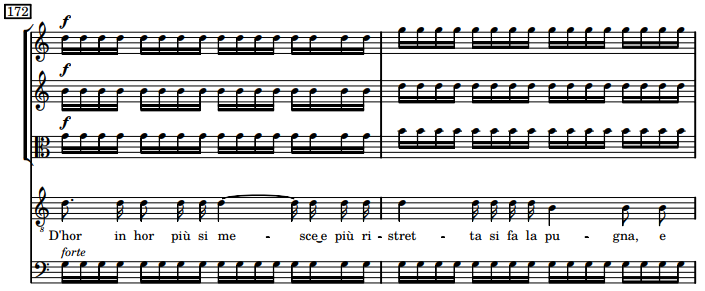Stile Concitato on:
[Wikipedia]
[Google]
[Amazon]
''Stile concitato'' (rather ''Genere concitato'') or "''agitated style''" is a

Baroque
The Baroque (, ; ) is a style of architecture, music, dance, painting, sculpture, poetry, and other arts that flourished in Europe from the early 17th century until the 1750s. In the territories of the Spanish and Portuguese empires including t ...
style developed by Claudio Monteverdi
Claudio Giovanni Antonio Monteverdi (baptized 15 May 1567 – 29 November 1643) was an Italian composer, choirmaster and string player. A composer of both secular and sacred music, and a pioneer in the development of opera, he is considered ...
with effects such as having rapid repeated notes and extended trills as symbols of bellicose agitation or anger. Kate Van Orden points out a precedent in Clément Janequin's "La Guerre" (1528). Agathe Sueur points out similarities and ambiguities between Monteverdi's ''genere concitato'' and ''stile concitato'' in rhetoric and poetry.
Examples of ''stile concitato'' can be found in these works:
*Monteverdi: ''Il Combattimento di Tancredi e Clorinda
''Il combattimento di Tancredi e Clorinda'' (''The Combat of Tancredi and Clorinda''), SV 153, is an operatic ''scena'' for three voices by Claudio Monteverdi. The libretto is drawn from Torquato Tasso's ''La Gerusalemme Liberata''. It was firs ...
'' (written 1624)
*Monteverdi: ''Il ritorno d'Ulisse in Patria
''Il ritorno d'Ulisse in patria'' (Stattkus-Verzeichnis, SV 325, ''The Return of Ulysses to his Homeland'') is an List of operas by Claudio Monteverdi, opera consisting of a prologue and five acts (later revised to three), set by Claudio Montever ...
'' (1639)
*Monteverdi: ''L'incoronazione di Poppea
''L'incoronazione di Poppea'' ( SV 308, ''The Coronation of Poppaea'') is an Italian opera by Claudio Monteverdi. It was Monteverdi's last opera, with a libretto by Giovanni Francesco Busenello, and was first performed at the Teatro Santi Giovanni ...
'' (1642)
*Giacomo Carissimi
(Gian) Giacomo Carissimi (; baptized 18 April 160512 January 1674) was an Italian composer and music teacher. He is one of the most celebrated masters of the early Baroque or, more accurately, the Roman School of music. Carissimi established the ...
(1605–1674): ''Jephte''
* Barbara Strozzi (1619–1677): ''Tradimento''
History
The earliest description of ''stile concitato'' comes from the foreword to ''Madrigali guerrieri, et amorosi'' ("Madrigals of war and love"), Claudio Monteverdi’s eighth and final book of madrigals, published in 1638. Monteverdi wrote the following:I have reflected that the principal passions or affections of our mind are three, namely, anger, moderation, and humility or supplication… The art of music also points clearly to these three in its terms "agitated," "soft," and "moderate" (''concitato, molle,'' and ''temperato''). In all the works of former composers I have indeed found examples of the "soft" and the "moderate," but never of the "agitated."Monteverdi developed the musical style of ''stile concitato'' to represent the human emotion of agitation. He considered ''
Il combattimento di Tancredi e Clorinda
''Il combattimento di Tancredi e Clorinda'' (''The Combat of Tancredi and Clorinda''), SV 153, is an operatic ''scena'' for three voices by Claudio Monteverdi. The libretto is drawn from Torquato Tasso's ''La Gerusalemme Liberata''. It was firs ...
'', one of the pieces from ''Madrigali guerrieri, et amorosi'', to be the first instance of ''stile concitato''. ''Stile concitato'' is represented musically in ''Il combattimento di Tancredi e Clorinda'' through the rapid repetition of sixteenth notes.

References